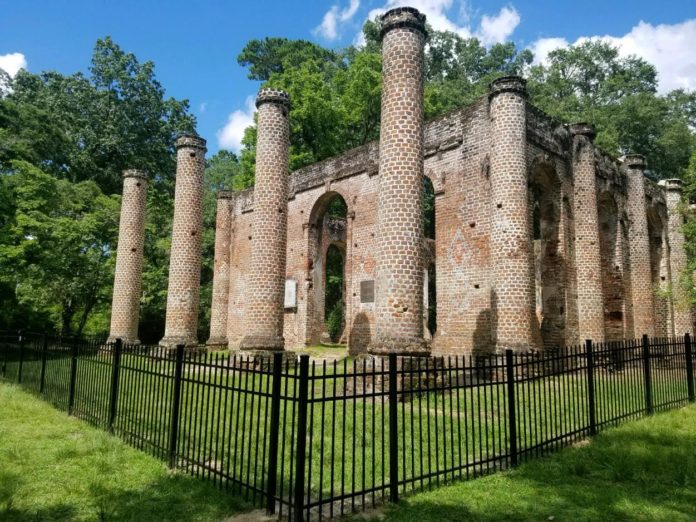The Old Sheldon Church Ruins, originally known as Prince William’s Parish Church on Old Sheldon Church Road, was built between 1745 and 1753 in a Greek Revival style of architecture. The Church is said to be the first attempt to imitate a Greek temple in America. The parish was carved out of a part of St. Helena’s Parish and named in honor of Prince William of Orange, son of George II. The Yemassee Indians had inhabited the area until 1715, when they were driven out as a result of the Yemassee Indian War.
If those beautiful walls and columns could speak, what a story they would tell.
The original walls and the four columns remain attesting to the solid construction and master craftsmanship which enabled it to withstand its 250 years of age. Completed by 1753, history claims the structure was burned by the British in 1779 during the Revolutionary War. In 1826 it was rebuilt and legend again says it was later burnt by William Tecumseh Sherman who burned practically all the residences of neighboring plantations following the evacuation of Pocataligo by the Confederates, Jan. 14, 1865.
The following is from an article in the April 1969 Sandlapper Magazine by Charles E. Thomas described Sheldon’s second burning: “All that was combustible was consumed. Its massive walls survived the last as they did the former conflagration,he wrote, exactly as it happened a hundred years before in 1779, when General Prevost, marching from Savannah into South Carolina burned the church, so now in February 1865, General Sherman marching from Georgia into South Carolina, burned it a second time.”
However another account more recently states that the church was not burnt at all.
In a letter from February of 1866, Beaufort’s Miton Leverett wrote that “Sheldon Church not burnt. Just torn up in the inside, but can be repaired.” The assumption is that the inside of the church was gutted to reuse materials in rebuilding homes around the are that were burned by Sherman’s army.
Whatever the accurate story actually is, the ruins today are surrounded by old majestic, spanish moss filled Oaks and gravesites are scattered throughout the grounds.
Inside the ruins of the church lie the remains of Colonel William Bull, who assisted General Oglethorpe in establishing the physical layout of Savannah, Georgia. Bull surveyed the land in 1733 to form the basic grid pattern of the streets and squares, to which Savannah is now famous for.
The site was listed in the National Register on October 22nd, 1970.
It’s considered one of the most peaceful, pristine and most sacred spots in the entire Lowcountry.










